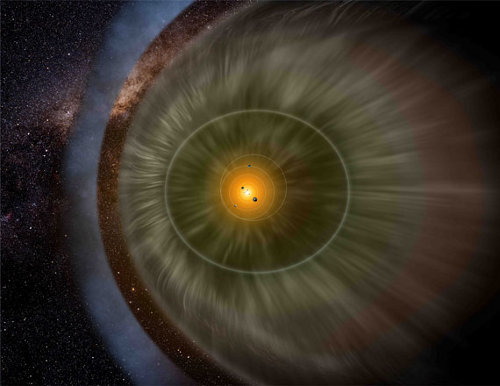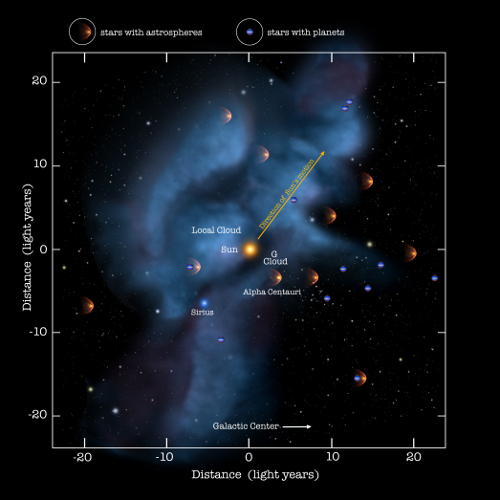The beauty of having spacecraft that far outlive their expected lives is that they can corroborate and supplement data coming in from much newer missions. That’s the case with our Voyager spacecraft as they continue their progress at system’s edge. The Voyagers will be moving outside the heliopause in not so many years, and when they do, they will tell us much about the behavior of charged particles in the interstellar medium. This will bulk up incoming results from IBEX, the Interstellar Boundary Explorer spacecraft, as it studies the neutral particles that routinely penetrate the heliosphere. Our knowledge of true interstellar space is growing.
It’s at the heliopause that we see the boundary between the area defined by the solar wind flowing outward from the Sun and the interstellar medium that surrounds it. Racing outward at an average of 440 kilometers per second, the solar wind is pushing into a region of dust and ionized gas, inflating the bubble we know as the heliosphere. The entire heliosphere incorporates the Sun and all the planets. Because interstellar neutral atoms do not interact with magnetic fields, they move through the heliopause readily, while charged particles do not. Hence the utility of the Voyagers, which will now move into a region from which we’ve had no prior data return.

Image: An artist’s rendition of a portion of our heliosphere, with the solar wind streaming out past the planets and forming a boundary as it interacts with the material between the stars. Credit: Adler Planetarium/IBEX team.
IBEX is a long way from the heliopause, orbiting the Earth with an apogee of 322,000 kilometers and a perigee of 16,000 kilometers, but its instruments are designed to map the distant interactions between the solar wind and ionized interstellar material, creating a map of the boundary. In addition, its low-energy energetic neutral atom camera is measuring inflowing interstellar neutral particles of the kind first measured by the Ulysses spacecraft. The IBEX measurements, recently discussed in a set of new papers, are helping us map the distribution of elements like hydrogen, helium, neon and oxygen as they enter the heliosphere from the local interstellar medium. By contrast, Ulysses was only able to detect neutral interstellar helium.
One thing we’re learning is the shape of the heliosphere. Interstellar neutral atoms enter the heliosphere at a speed of roughly 84,000 kilometers per hour. That’s a good deal slower than what Ulysses found, and IBEX sees the neutral particles entering the heliosphere from a somewhat different direction. “With this lower speed, the external magnetic forces cause the heliosphere to become more squished and misshapen,” says David McComas (SwRI), IBEX principal investigator. “Rather than being shaped like a bullet moving through the air, the heliosphere becomes flattened, more like a beach ball being squeezed when someone sits on it.”
IBEX is also showing us that our Sun is located in a region of space where dust and gas are extremely thinly dispersed, a situation different from the relative abundances of certain elements during the period when the Sun was formed. The neon to oxygen ratio in the Sun offers a glimpse of what the abundances of those elements were in that early era. IBEX, by measuring oxygen and neon from the interstellar medium, is finding less oxygen than expected, an indication of possible changes in the medium during the Sun’s lifetime. Alternatively, it is possible that the oxygen is still present but locked up in ice grains in the local interstellar material. McComas again:
“Our solar system is different than the space right outside it, suggesting two possibilities. Either the solar system evolved in a separate, more oxygen-rich part of the galaxy than where we currently reside, or a great deal of critical, life-giving oxygen lies trapped in interstellar dust grains or ices, unable to move freely throughout space.”
Interstellar space is far from empty, and IBEX is showing us what our early interstellar precursor missions may encounter. The Sun is evidently close to the boundary of a local cloud of gas and dust, one of many such clouds in our local galactic neighborhood. Ulysses results had indicated the Sun was placed between the ‘Local Cloud’ and the ‘G-Cloud,’ close to the boundary of the Local Cloud. The new IBEX work challenges this assumption, finding that the heliosphere is still fully within the Local Cloud. But we’re moving quickly (within a few thousand years at most) to leave the Local Cloud and move into what McComas calls ‘a much different galactic environment.’ IBEX and the Voyagers, then, are filling in our knowledge not only of the heliopause but the regions that surround our system as we move through the galaxy.

Image: The solar journey through space is carrying us through a cluster of very low density interstellar clouds. Right now the Sun is inside of a cloud that is so tenuous that the interstellar gas detected by IBEX is as sparse as a handful of air stretched over a column that is hundreds of light years long. These clouds are identified by their motions. Credit: NASA/Goddard/Adler/U. Chicago/Wesleyan.
Make no mistake about the importance of the heliosphere — it is an important zone of protection against dangerous cosmic radiation, and thus has implications for the evolution of life, given that varying levels of radiation create genetic mutations and possible extinctions. How the makeup of the interstellar medium affects the heliosphere is thus a major issue, and changes as we move outside the Local Cloud could affect the heliosphere in ways we don’t yet understand. We’ll also use IBEX data to inform our studies of the analogous ‘astrospheres’ surrounding other stars.
Coda: Does any of this business about moving out of a local cloud and into more open interstellar space evoke for anyone else the same pleasing memories of Poul Anderson’s Brain Wave (1954)? Just checking.
The papers on the recent IBEX findings appeared in a Special Supplements issue of the Astrophysical Journal called “Interstellar Boundary Explorer (IBEX): Direct Sampling of the Interstellar Medium,” which appeared on January 31.



As we learn more about the boundary layer between the heliosphere and interstellar space , it seems to play a role paralel or complementary to the boundary layer between the van allen belts and the solar wind .
” Charged particles” cant get through , but what does that include ?
What about a bacteriazyst -sized particle with a week electrical charge in relation to its mass ? Could it perhabs be slowed down from relativistic speeds in a treestage braking process , in the helioshere , the van allen belts and finaly the planetary atmosphere ?
Only one way to find out !
THANKS FOR THE TIP ABOUT ‘BRAIN WAVE’ WILL GET A COPY ASAP.
WHAT A BEAUTIFUL BLUE RENDERING OF OUR NEAR SPACE.
INTERSTELLAR NAVIGATION AT SUB LIGHT SPEED IS A NEGLECTED TOPIC SINCE MAKING CHOICES WOULD BE SPECULATION HERE IN THE 21ST CENTURY. BUT ONE MUST EVENTUALLY CHOOSE A STARTING POSITION AND BEGIN CHARTING ALTERNATE TRAJECTORIES FOR OUR FRISBE-SHAPED ROBOT MANNED SMART BULLET CALLED CENTAURI DREAM.
JAMES D. STILWELL
Is that really true? It is my understanding that our atmosphere is very effective at stopping any and all ionizing radiation from space before it can harm any surface-based organisms.
Eniac, my thought is that expansion of the heliosphere as our system moves out of the Local Cloud into even emptier interstellar space could cause its ability to protect the inner system from galactic cosmic rays to vary. Whether this would be enough to cause problems on the surface through our atmosphere (admittedly effective at blocking radiation) is something I don’t know, but I don’t think we can rule out the possibility. Anyone else have thoughts on this?
Here’s a science idea and a mission profile for near-term starship designers: a Stardust sample return mission beyond the heliopause. These samples would be far less contaminated by solar system particles than the Stardust mission. It would collect far more dust originated from other star systems.
The mission profile requires a high delta-v: accelerate out, decelerate, reverse course, accelerate back, decelerate, drop the sample capsule into earth’s atmosphere.
Most of the important things we can do with or figure out from macroscopic lunar samples or meteorites from Mars, we can figure out from samples of dust. With sufficient cleverness, we might be able to figure out which stars particular pieces of dust came from — or even discern the rare piece of dust that comes from a particular extrasolar planet.
My understanding of charged particles in the ISM is that they can deflect but not stop cosmic rays. This is the reason why it is difficult to determine their source since their trajectory when they approach Earth does not point back to the source. It would take a special configuration and density of the ISM surrounding the heliopause to reliably deflect away cosmic rays instead of merely randomizing their trajectories. You once had an article that discussed this in respect to a speculative 65-million year extinction cycle due to the solar system’s periodic motion across the galactic plane.
Ron S: “My understanding of charged particles in the ISM is that they can deflect but not stop cosmic rays. This is the reason why it is difficult to determine their source [deflection by the ISM tends to randomize them]”
This is a very interesting observation. How far out does the detector need to be (e.g. beyond the heliopause?) for this deflection to be small enough that many more cosmic ray sources can be determined? If this happens near the heliopause, it’s yet another good reason to send a well-equipped (in this case with a cosmic ray detector) science mission out there.
Nick, it would depend on a couple of things: the density of the solar wind (which of course declines with distance) and the distance of the source (farther means more opportunity for deflection).
In the first case the heliopause is likely unimportant. The probability of deflection will predictably decline as you move outward so with enough sample particles you can better zero in on the source. I don’t have references handy, but I believe there is already data on the improvement in source determination when the sun is quiet.
Extra-galactic sources are still a problem since there are just so many opportunities for encounters with ionized clouds long before they get here. Again, I don’t have references handy, but I do recall that there has been some success with associating some portion of cosmic rays with galactic sources (I seem to remember supernovas as strong candidates). In this case, it would help to get further away from the sun.
Interstellar dust , might contain a goldmine of information including anwers to some of of the hard conditions that would face a real starship . The IBEXs instruments are aparently only measuring atomic particles , leaving out the bigger dust particles . These particle are mostly sislicates or condrites , and some of them seems to contain a RECORD of what they ran into in space . A statistical analysis of this record , combined with a better general undestanding of the pocesses involved , might lead to the beginning of an understanding of the destructive forces that would face an interstellar starship .
Some of this dust is identical to the cometdust that was collected already by two separate missions , and so it would would be interresting to know , if any of the people who are now studying the dust , are actually looking at it from that point of wiev ?